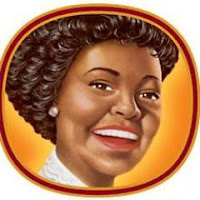Aunt Jemima and Systems of Representation
While reading Micki McElya's Clinging to Mammy, I discovered the origins of the Aunt Jemima brand and the overplayed faithful slave trope. The excerpt that I read shed light on the creation of the faithful slave symbol, a tactic used by white southerners to disguise the atrocities involved with slavery. Following the Emancipation Proclamation, many freed slaves began to share their stories with the world by writing their own personal narratives regarding their former lives. White men from the south were shocked and angered to see that they had been painted as monsters who abused and raped many of their slaves. They rejected any attack on their character and decided to create a new narrative to protect their honor and white identity. They did this by creating the "Mammy" figure, an old woman who enjoyed serving her white masters. They described this mammy as a joyous, sassy woman who loved the family she worked for as her own. It was imperative to paint black people as faithful slaves who did not consider themselves slaves at all but rather a part of the family. By desexualizing this icon, they could also distance themselves even further from the rape accusations.
I connected this piece with Lyon and Olson's theories in Special Issues on Human Rights Rhetoric: Traditions of Testifying and Witnessing. The line that stood out to me was "The
systems of representation reflect the histories of domination and power within
them." (Lyon
and Olson, p. 205). It is obvious that white men in this time period used their power and influence to erase the history that did match their own narrative. The system of representation that they created was able to further oppress black people and remove their freedom of speech.
After reading Clinging to Mammy, it was clear to me that those in power have always, and will
continue, to control the narrative and suppress marginalized groups from having
a voice. “In general, a rhetorical approach to human rights considers the
human rights implications of language and symbolism by examining the
hierarchical significance of words, definitions, redefinitions, symbols
designating social groupings, myths, rituals, symbolic images, and the like” (Lyon and Olson, 905). Using the word faithful when describing the slaves they believed to have fully represents the environment in which they were brought up in, in regards to their use of language. The significance of the Aunt Jemima symbol, even in its circulation today, proves the power of symbols and their hierarchical implications.


Comments
Post a Comment